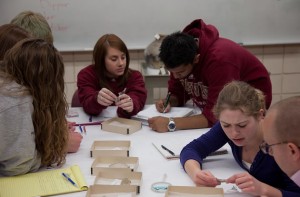Often our classes involve teaching students a procedural, psychomotor, or cognitive skill. Skill-based learning goals are not effectively taught through lectures or discussions, but rather involve students actually practicing the skill with the use of feedback to continually fine tune and improve the skill.
 Skill development is a part of many classes. Whether it is teaching foreign language vocabulary pronunciation, solving routine math problems, practice with writing conventions, or operating complex equipment, many tasks can only be learned by the students practicing the skill over and over again.
Teaching skill development involves breaking down the skill into manageable components, often called tasks and sub-tasks. By breaking apart a complex skill, it’s easier to teach the reasons behind the use of a specific task, easier for students to practice sub-tasks, and easier to assess and diagnose exactly what students can do to improve their skill.
Feedback is an essential part of teaching skills. There is no use in practicing incorrect parts of a skill, so feedback needs to be timely and supportive to help learning. And as classic studies in behavioral learning have taught us, positive incentives of good work are much better motivators for learning than negative reinforcement. Our feedback should be precise and give students an idea of how to improve. Feedback does not always need to come from the instructor, it can come from peers, self-assessment through rubrics, and sometimes other sources.
Skill development is a part of many classes. Whether it is teaching foreign language vocabulary pronunciation, solving routine math problems, practice with writing conventions, or operating complex equipment, many tasks can only be learned by the students practicing the skill over and over again.
Teaching skill development involves breaking down the skill into manageable components, often called tasks and sub-tasks. By breaking apart a complex skill, it’s easier to teach the reasons behind the use of a specific task, easier for students to practice sub-tasks, and easier to assess and diagnose exactly what students can do to improve their skill.
Feedback is an essential part of teaching skills. There is no use in practicing incorrect parts of a skill, so feedback needs to be timely and supportive to help learning. And as classic studies in behavioral learning have taught us, positive incentives of good work are much better motivators for learning than negative reinforcement. Our feedback should be precise and give students an idea of how to improve. Feedback does not always need to come from the instructor, it can come from peers, self-assessment through rubrics, and sometimes other sources.
 Skill development is a part of many classes. Whether it is teaching foreign language vocabulary pronunciation, solving routine math problems, practice with writing conventions, or operating complex equipment, many tasks can only be learned by the students practicing the skill over and over again.
Teaching skill development involves breaking down the skill into manageable components, often called tasks and sub-tasks. By breaking apart a complex skill, it’s easier to teach the reasons behind the use of a specific task, easier for students to practice sub-tasks, and easier to assess and diagnose exactly what students can do to improve their skill.
Feedback is an essential part of teaching skills. There is no use in practicing incorrect parts of a skill, so feedback needs to be timely and supportive to help learning. And as classic studies in behavioral learning have taught us, positive incentives of good work are much better motivators for learning than negative reinforcement. Our feedback should be precise and give students an idea of how to improve. Feedback does not always need to come from the instructor, it can come from peers, self-assessment through rubrics, and sometimes other sources.
Skill development is a part of many classes. Whether it is teaching foreign language vocabulary pronunciation, solving routine math problems, practice with writing conventions, or operating complex equipment, many tasks can only be learned by the students practicing the skill over and over again.
Teaching skill development involves breaking down the skill into manageable components, often called tasks and sub-tasks. By breaking apart a complex skill, it’s easier to teach the reasons behind the use of a specific task, easier for students to practice sub-tasks, and easier to assess and diagnose exactly what students can do to improve their skill.
Feedback is an essential part of teaching skills. There is no use in practicing incorrect parts of a skill, so feedback needs to be timely and supportive to help learning. And as classic studies in behavioral learning have taught us, positive incentives of good work are much better motivators for learning than negative reinforcement. Our feedback should be precise and give students an idea of how to improve. Feedback does not always need to come from the instructor, it can come from peers, self-assessment through rubrics, and sometimes other sources.
Tips for helping students build skills
- Break complex learning activities into steps and substeps, arranged in hierarchical or sequential order if necessary.
- Model the skill, but allow the students time and opportunity to practice. They won’t learn how to perform a skill only by watching someone else.
- Use various forms of well-timed and specific feedback to shape students’ behavior.
- Find appropriate motivation for students in the form of positive reinforcers.


